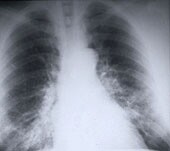
THURSDAY, Jan. 9, 2014 (HealthDay News) — As fewer Americans smoke, the number of people who develop lung cancer continues to drop, U.S. health officials report.
Between 2005 and 2009, lung cancer rates went down 2.6 percent each year among men, from 87 to 78 cases per 100,000, and decreased 1.1 percent each year among women, from 57 to 54 cases per 100,000, according to the U.S. Centers for Disease Control and Prevention.
“This is encouraging because lung cancer rates were going up among women, but they are starting to come down now,” said report author S. Jane Henley, a CDC epidemiologist.
These declining rates are largely the result of fewer people smoking cigarettes, she noted.
“Smoking prevalence has been decreasing for several years, and that’s finally paying off. This is largely due to increased tobacco control, including increases in tobacco prices and more smoke-free laws, which protect both smokers and nonsmokers,” Henley said.
Despite all efforts, however, almost 20 percent of American adults still smoke, Henley said, but “we are seeing some declines among youth that drop smoking below 10 percent, which is very encouraging.”
To get at that reluctant 20 percent, Henley thinks more needs to be done to make smoking unattractive. “Increasing tobacco prices will make a big difference. It seems to make the biggest difference for young adults,” she said.
In addition, more smoke-free laws and stronger enforcement of them would also make a difference in getting more people to quit, Henley said.
The message from Henley is clear: If you smoke, stop. If you don’t, don’t start. “Quitting is very hard, but there are a lot of resources to help you quit,” she said.
The report was published Jan. 10 in the CDC’s Morbidity and Mortality Weekly Report.
“The good news is that for most age groups, lung cancer rates are declining, particularly and most rapidly among men,” said Rebecca Siegel, director of surveillance information at the American Cancer Society.
“This is a true testament to the success of the tobacco control movement. The lag in decline for women reflects their later uptake of smoking,” she noted.
For example, there was a surge in the number of girls who started smoking in the 1970s, which was fueled by targeted advertising by the tobacco companies. This increase is reflected by the lack of decline in lung cancer among women aged 45 to 54, who were teens during that time, Siegel said.
Dr. Norman Edelman, a senior medical adviser to the American Lung Association, commented: “We are continuing to win the war, but there is a whole lot more to be done.”
Edelman said more money needs to be spent by the states on tobacco control programs. “There are very few states that are spending a significant amount of money on tobacco control,” he pointed out.
In 2010, states used only 2.4 percent of the millions they receive in tobacco revenues for tobacco control, according to the CDC.
To target people who continue to smoke, Edelman thinks a variety of approaches are needed. “The most effective thing is simply increasing the cost. One solution would be a substantial increase of the federal tax on cigarettes,” he suggested.
Most people who smoke want to quit, but it’s hard and often takes several tries, so more effort is needed to make smoking cessation programs available, Edelman added.
Edelman also believes that the U.S. Food and Drug Administration needs more power over tobacco companies.
This month is the 50th anniversary of the first U.S. Surgeon General’s report linking cigarette smoking to lung cancer, Edelman noted.
“Over that time, we have saved many millions of lives and we have reduced the smoking rate from about 40 percent to about 20 percent — we ought to celebrate the victory, but recognize there is a way to go,” he said.
According to the CDC report, the most rapid decline in lung cancer rates was among adults aged 35 to 44. Men in this age group saw a decrease of 6.5 percent a year, while women saw a 5.8 percent decrease.
In all age groups, lung cancer rates dropped faster among men than among women, the researchers found.
Lung cancer incidence decreased among men across all regions of the United States and in 23 states, and decreased among women in the South and West and seven states, the investigators reported.
Lung cancer remains the leading cause of cancer death and the second most commonly diagnosed cancer in the United States, according to the report.
More information
Visit the American Lung Association for more on lung cancer.
Copyright © 2025 HealthDay. All rights reserved.

